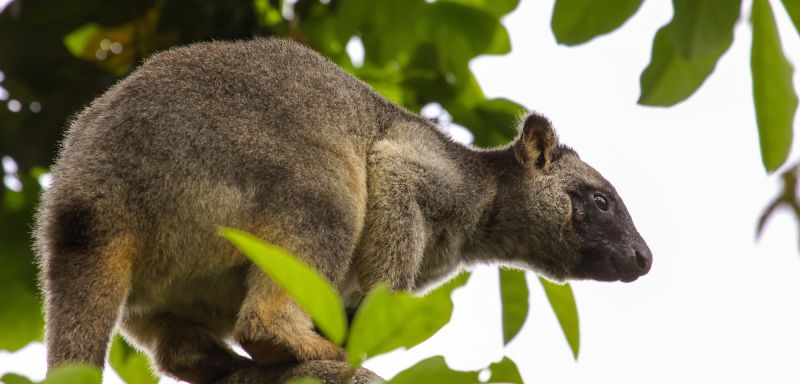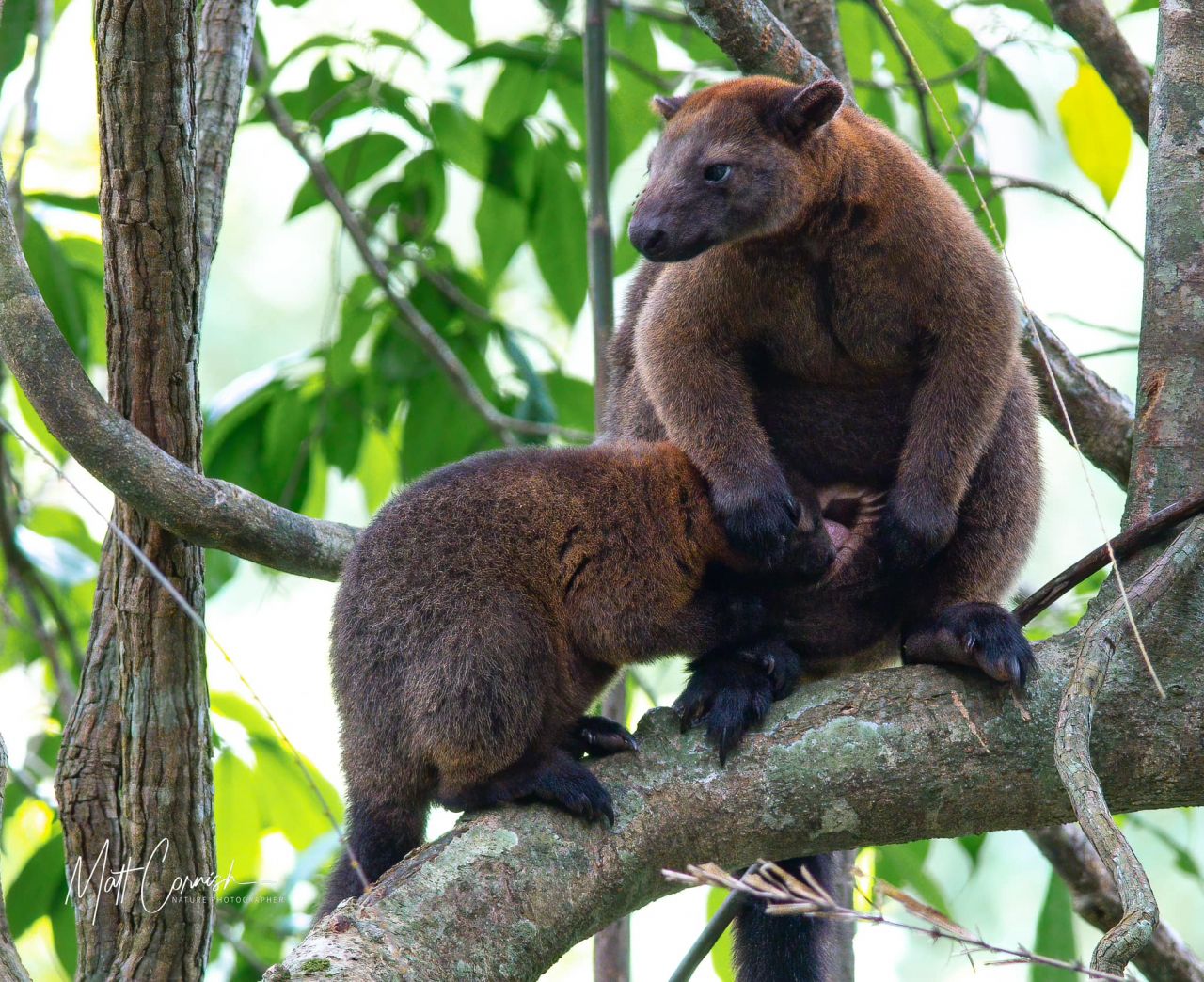When most people picture a kangaroo, they imagine an animal bounding across the open plains. But in the cool, dense rainforests of Far North Queensland, two unique species have adapted to life in the treetops: The Lumholtz's Tree-kangaroo (Dendrolagus lumholtzi) and the Bennett's Tree-kangaroo (Dendrolagus bennettianus). These remarkable marsupials are the only kangaroos in Australia that have evolved to live almost entirely off the ground, climbing and leaping through the canopy with surprising grace. Rarely seen but deeply symbolic of the Wet Tropics' biodiversity, tree-kangaroos embody both the fragility and resilience of Australia's rainforests.
Size and appearance
Tree-kangaroos differ noticeably from their terrestrial cousins. They have shorter, stockier builds, long muscular forelimbs, and strong curved claws designed for climbing. Their tails are exceptionally long and heavy, providing balance as they move through the trees.
- Lumholtz's Tree-kangaroo is the smaller of the two species, measuring 48-65 cm in body length, with tails almost as long again (60-75 cm). Adults weigh 7-12 kg, with males generally larger. Their fur is dark brown to almost black above, paler below, and their faces are often darker than their bodies.
- Bennett's Tree-kangaroo is Australia's largest tree-kangaroo, reaching 80 cm in body length, with tails up to 90 cm. Adults can weigh 11-14.5 kg, occasionally more. Their fur is chocolate brown with reddish tones, often with a pale belly and distinct lighter patches around the muzzle and ears.
Both species look somewhat like a cross between a kangaroo and a bear, with a deliberate, climbing gait on the ground but surprising agility in the canopy.
Behaviour & Diet
Tree-kangaroos are largely solitary, with overlapping home ranges. They are most active at night, though they may also feed during the day in shaded forest. Unlike rock-wallabies or ground kangaroos, they move slowly and deliberately when foraging, but can leap several metres between branches when threatened.
Their diet consists of leaves, fruit, flowers, and bark. They show preferences for certain rainforest trees and vines, browsing high in the canopy where food is abundant. Lumholtz's are thought to be more folivorous (leaf-eating), while Bennett's often eat more fruit when available. They descend to the ground occasionally to move between trees, drink, or feed on fallen fruit.
Tree-kangaroos play an important ecological role as seed dispersers. By consuming rainforest fruits and moving between trees, they help maintain the diversity and regeneration of their habitats.

Lumholtz's Tree-kangaroo in the Atherton Tablelands. Image: FNQ Nature Tours
Breeding & Life Cycle
Like other kangaroos, tree-kangaroos give birth to tiny, underdeveloped young that crawl into the mother's pouch after a short gestation (around 44 days). The joey remains in the pouch for about 9 months, and continues to suckle after first leaving, only weaning fully at around 2 years of age.
Breeding may occur year-round, but females typically rear one joey at a time, meaning reproductive rates are low. This makes populations particularly vulnerable to habitat loss and other threats, as recovery is slow.
Both Lumholtz's and Bennett's are long-lived animals; in captivity, individuals have reached 15-20 years.
Conservation & Threats
Both species are endemic to a small part of Far North Queensland and are listed as Near Threatened by the IUCN.
- Lumholtz's Tree-kangaroo has the more restricted range, confined to the Atherton Tablelands and surrounding rainforests.
- Bennett's Tree-kangaroo occurs in lowland and mid-elevation rainforest from just south of Cooktown to the Daintree River, with a patchy distribution.
The primary threats to both species are:
- Habitat loss and fragmentation, particularly the clearing of lowland rainforest for agriculture and development.
- Vehicle collisions, as animals crossing roads between forest patches are vulnerable at night.
- Dog attacks, especially near towns and farms on the Tablelands.
- Climate change, which threatens to shift suitable rainforest habitats upslope, squeezing already restricted populations.
Recent concerns have arisen over neurological conditions observed in some Lumholtz's Tree-kangaroos, leading to blindness and disorientation. The causes are still being investigated but may be linked to toxins in food plants or emerging diseases.
Conservation efforts focus on protecting and reconnecting rainforest habitat, reducing road mortality, and engaging local communities in coexistence strategies.

Bennett's Tree-kangaroo joey feeding from the mother's pounch in the Daintree Rainforest. Image: Matt Cornish/FNQ Nature Tours
Where to see Tree-kangaroos in the wild
Tree-kangaroos are elusive, but patient visitors to the Wet Tropics may be rewarded.
- Lumholtz's Tree-kangaroo is best seen around the Atherton Tablelands. Places like Yungaburra, Malanda Falls Conservation Park, and Nerada Tea Plantation sometimes host animals that have become accustomed to humans. Local wildlife tours also know reliable viewing sites.
- Bennett's Tree-kangaroo is harder to see, preferring remote lowland rainforest. They are occasionally sighted in the Daintree region and Mount Lewis area, but encounters are less frequent.
The best chance is to look quietly at dawn or dusk, scanning the canopy edges where movement may reveal their slow climbing. A good pair of binoculars increases success.
FAQs
How many tree-kangaroo species are there?
Globally, there are around 14 species of tree-kangaroo, most in New Guinea. Australia has only two: Lumholtz's and Bennett's.
Are they good climbers?
Yes. Despite their stocky appearance, tree-kangaroos are excellent climbers, using strong limbs and tails for balance. They can leap several metres between branches.
Can they come to the ground?
They do, but awkwardly. On the ground they move with a slow hopping walk, quite unlike the bounding gait of open-country kangaroos.
Why are they threatened?
Their restricted rainforest range and low reproductive rate make them highly vulnerable to habitat loss, vehicle strikes, and dogs.
What's the difference between Lumholtz's and Bennett's?
Size is the main difference: Bennett's is larger and often has a reddish tinge, while Lumholtz's is smaller and darker. Their ranges also don't overlap, with Bennett's further north.

